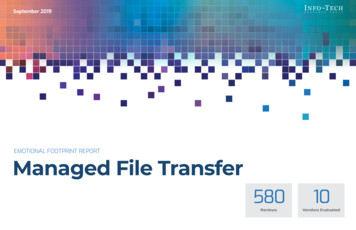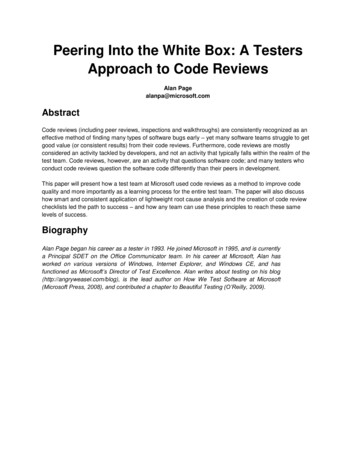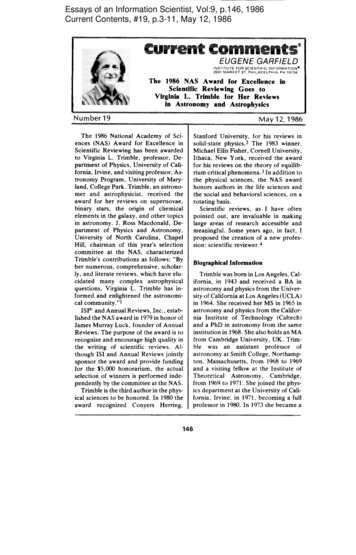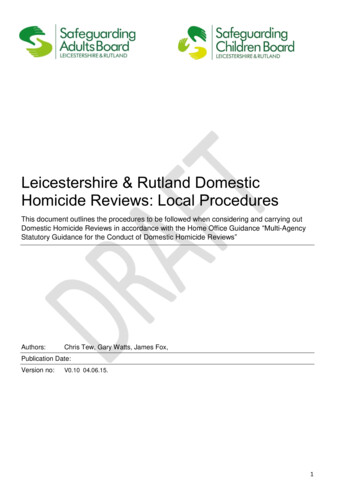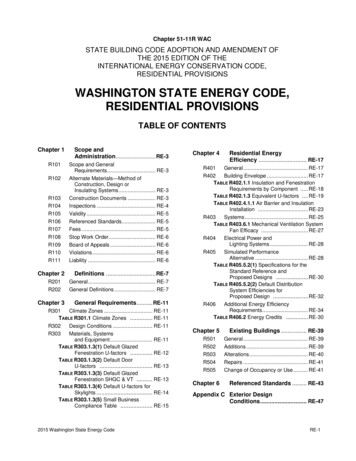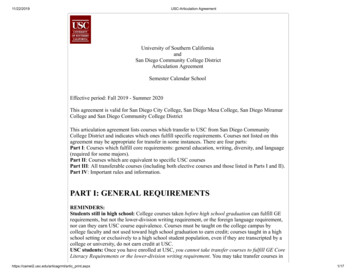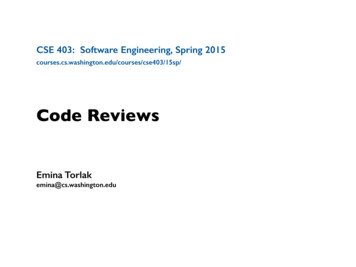
Transcription
CSE 403: Software Engineering, Spring Code ReviewsEmina Torlakemina@cs.washington.edu
Outline What is code review? Kinds of code review Example2
introcode reviews: what and why
Assuring software quality is hard 4
Assuring software quality is hard What are we assuring? Building the right system Building the system right correct, secure, reliable, available usable, cost effective, maintainable4
Assuring software quality is hard What are we assuring? Building the right system Building the system right correct, secure, reliable, available usable, cost effective, maintainable Why are we assuring it? Business, legal, ethical, social reasons4
Assuring software quality is hard What are we assuring? Building the right system Building the system right correct, secure, reliable, available usable, cost effective, maintainable Why are we assuring it? Business, legal, ethical, social reasons How do we assure it?4
Assuring software quality is hard What are we assuring? Building the right system Building the system right correct, secure, reliable, available usable, cost effective, maintainable Why are we assuring it? Business, legal, ethical, social reasons How do we assure it? How do we know we have assured it?4
Challenges of building large systems How to ensure maintainable, DRY,readable, bug-free code? Average defect detection rate forvarious testing approaches Unit testing: 25% Function testing: 35% Integration testing: 45% How can we do better?5
Code reviews6
Code reviews Code review: A constructive review of afellow developer’s code. A required sign-offfrom another team member before adeveloper is permitted to check in changesor new code.6
Code reviews Code review: A constructive review of afellow developer’s code. A required sign-offfrom another team member before adeveloper is permitted to check in changesor new code. Analogy: when writing articles for anewspaper, what is the effectiveness of spell-check/grammar check? author editing own article? others editing others’ articles?6
Code reviews: mechanics7
Code reviews: mechanics Who: original developer and reviewer, sometimestogether in person, sometimes offline.7
Code reviews: mechanics Who: original developer and reviewer, sometimestogether in person, sometimes offline. What: reviewer gives suggestions forimprovement on a logical and/or structural level,to conform to a common set of quality standards. Feedback leads to refactoring. Reviewer eventually approves code.7
Code reviews: mechanics Who: original developer and reviewer, sometimestogether in person, sometimes offline. What: reviewer gives suggestions forimprovement on a logical and/or structural level,to conform to a common set of quality standards. Feedback leads to refactoring. Reviewer eventually approves code. When: code author has finished a coherentsystem change that is otherwise ready for checkin Change shouldn't be too large or too small. Before committing the code to the repository orincorporating it into the new build.7
Code reviews: why do them?8
Code reviews: why do them? Improved code quality Prospect of someone reviewing your code raisesquality threshold. Forces code authors to articulate their decisions.8
Code reviews: why do them? Improved code quality Prospect of someone reviewing your code raisesquality threshold. Forces code authors to articulate their decisions. Hands-on learning experience from peers Direct feedback leads to better algorithms, tests,design patterns.8
Code reviews: why do them? Improved code quality Prospect of someone reviewing your code raisesquality threshold. Forces code authors to articulate their decisions. Hands-on learning experience from peers Direct feedback leads to better algorithms, tests,design patterns. Better understanding of complex code bases Reviewing others’ code enhances overallunderstanding of the system, reduces redundancy.8
Code reviews: studies9
Code reviews: studies Average defect detection rates Unit testing: 25% Function testing: 35% Integration testing: 45% Design and code inspections: 55% and 60%.9
Code reviews: studies Average defect detection rates Unit testing: 25% Function testing: 35% Integration testing: 45% Design and code inspections: 55% and 60%. 11 programs developed by the same group of people First 5 without reviews: average 4.5 errors per 100 lines of code Next 6 with reviews: average 0.82 errors per 100 lines of code Errors reduced by 80 percent.9
Code reviews: who does them?10
Code reviews: who does them? Everyone: a common industry practice.10
Code reviews: who does them? Everyone: a common industry practice. Made easier by advanced tools that integrate with version control highlight changes (i.e., diff function) e.g., github pull requests10
kindskinds of code reviews
Common types of code review Tool-assisted reviews Formal inspections Walkthroughs Pair programming12
Tool-assisted code reviews13
Tool-assisted code reviews Most common form of code review Authors and reviewers use software toolsdesigned for peer code review. The tool gathers files, displays diffs andcomments, enforces reviews.13
Tool-assisted code reviews Most common form of code review Authors and reviewers use software toolsdesigned for peer code review. The tool gathers files, displays diffs andcomments, enforces reviews. Advantages Lightweight, integrated into the workflow.13
Tool-assisted code reviews Most common form of code review Authors and reviewers use software toolsdesigned for peer code review. The tool gathers files, displays diffs andcomments, enforces reviews. Advantages Lightweight, integrated into the workflow. Disadvantages Hard to ensure review quality and promptness.13
Tool-assisted code reviews14
Formal inspections15
Formal inspections A more formalized code review with roles (moderator, author, reviewer, scribe, etc.) several reviewers looking at the same piece of code a specific checklist of kinds of flaws to look for flaws that have been seen previously high-risk areas such as security15
Formal inspections A more formalized code review with roles (moderator, author, reviewer, scribe, etc.) several reviewers looking at the same piece of code a specific checklist of kinds of flaws to look for flaws that have been seen previously high-risk areas such as security Advantages High review quality with specific expected outcomes(e.g. report, list of defects)15
Formal inspections A more formalized code review with roles (moderator, author, reviewer, scribe, etc.) several reviewers looking at the same piece of code a specific checklist of kinds of flaws to look for flaws that have been seen previously high-risk areas such as security Advantages High review quality with specific expected outcomes(e.g. report, list of defects) Disadvantages Heavyweight, time-consuming, expensive15
Walkthroughs16
Walkthroughs An informal discussion of code between authorand a single reviewer. The author walks the reviewer through a set of codechanges.16
Walkthroughs An informal discussion of code between authorand a single reviewer. The author walks the reviewer through a set of codechanges. Advantages Simplicity in execution: anyone can do it, any time. In-person interaction, learning, and sharing.16
Walkthroughs An informal discussion of code between authorand a single reviewer. The author walks the reviewer through a set of codechanges. Advantages Simplicity in execution: anyone can do it, any time. In-person interaction, learning, and sharing. Disadvantages Not an enforceable process, no record of the review. Easy for the author to unintentionally miss a change. Reviewers rarely verify that defects were fixed.16
Pair programming17
Pair programming Two developers writing code at a singleworkstation with only one typing continuous free-form discussion and review17
Pair programming Two developers writing code at a singleworkstation with only one typing continuous free-form discussion and review Advantages Deep reviews, instant and continuous feedback. Learning, sharing, team-building.17
Pair programming Two developers writing code at a singleworkstation with only one typing continuous free-form discussion and review Advantages Deep reviews, instant and continuous feedback. Learning, sharing, team-building. Disadvantages Some developers don’t like it. No record of the review process. Time consuming.17
reviewa code review example
What changes, if any, would you suggest?public class Account {double principal,rate; int daysActive,accountType;public static final int STANDARD 0, BUDGET 1,PREMIUM 2, PREMIUM PLUS 3;}public static double calculateFee(Account[] accounts){double totalFee 0.0;Account account;for (int i 0;i accounts.length;i ) {account accounts[i];if ( account.accountType Account.PREMIUM account.accountType Account.PREMIUM PLUS )totalFee .0125 * (// 1.25% broker's feeaccount.principal * - account.principal);// interest-principal}return totalFee;}}19
Possible changes Comment. Make fields private. Replace magic values (e.g. 365.25) with constants. Use an enum for account types. Use consistent whitespace, line breaks, etc.20
Improved code (1/2)/** An individual account. Also see CorporateAccount. */public class Account {/** The varieties of account our bank offers. */public enum Type {STANDARD, BUDGET, PREMIUM, PREMIUM PLUS}/** The portion of the interest that goes to the broker. */public static final double BROKER FEE PERCENT 0.0125;private Type type;private double principal;/** The yearly, compounded rate (at 365.25 days per year). */private double rate;/** Days since last interest payout. */private int daysActive; 21
Improved code (2/2)/** Compute interest on this account. */public double interest() {double years daysActive / 365.25;double compoundInterest principal * Math.pow(rate, years);return compoundInterest – principal;}/** Return true if this is a premium account. */public boolean isPremium() {return accountType Type.PREMIUM accountType Type.PREMIUM PLUS;}/** Return the sum of broker fees for all given accounts. */public static double calculateFee(Account[] accounts) {double totalFee 0.0;for (Account account : accounts) {if (account.isPremium()) {totalFee BROKER FEE PERCENT * account.interest();}}return totalFee;}}22
Summary Code reviews improve code quality teamwork knowledge and skills Kinds of code review tool-assisted formal inspections walkthroughs pair programming23
Tool-assisted code reviews 13 Most common form of code review Authors and reviewers use software tools designed for peer code review. The tool gathers files, displays diffs and comments, enforces reviews. Advantages Lightweight, integrated into the workflow. Disadvantages Hard to ensure review quality and promptness.

